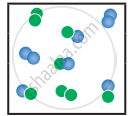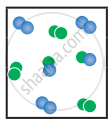Advertisements
Advertisements
प्रश्न
Derive a general expression for the equilibrium constant Kp and Kc for the reaction, \[\ce{3H2(g) + N2(g) <=> 2NH3(g)}\].
उत्तर
Let us consider the formation of ammonia in which, ‘a’ moles nitrogen and h’ moles hydrogen gas are allowed to react in a container of volume V. Let ‘x’ moles of nitrogen react with 3 x moles of hydrogen to give 2x moles of ammonia.
\[\ce{3H2(g) + N2(g) <=> 2NH3(g)}\]
| N2 | H2 | NH3 | |
| Initial number of moles | a | b | 0 |
| number of moles reacted | X | 3x | 0 |
| Number of moles at equilibrium | a -x | b - 3x | 2x |
| Active mass or molar concentration at equilibrium | `("a -x")/"V"` | `("b" - "3x")/"V"` | `(2x)/"V"` |
Applying law of mass action,
K2 = `(["NH"_3]^2)/(["N"_2]["H"_2]^3)`
= `("2x"/"V")^2/((("a - x")/"V")(("b" - 3"x")/"V")^3)`
= `("4x"^2/"V"^2)/((("a - x")/"V")(("b" - 3"x")/"V")^3)`
= `(4x^2"V"^2)/(("a - x")("b - 3x")^3)`
The equilibrium constant KP can also be calculated as follows:
`"K"_"P" = "K"_"C" ("RT")^(Delta"ng")`
Δng = np - nr = 2 - 4 = - 2
`"K"_"P" = (4x^2"V"^2)/(("a - x")("b - 3x")^3) xx ["RT"]^-2`
Total number of moles at equilibrium,
n = a - x + b - 3x + 2x = a + b - 2x
`"K"_"P" = (4x^2"V"^2)/(("a - x")("b - 3x")^3) xx ["PV"/"n"]^-2`
`"K"_"P" = (4x^2"V"^2)/(("a - x")("b - 3x")^3) xx ["n"/"PV"]^2`
`"K"_"P" = (4x^2"V"^2)/(("a - x")("b - 3x")^3) xx [("a + b - 2x")/"PV"]^2`
`"K"_"P" = (4x^2("a + b - 2x")^2)/("P"^2("a - x")("b - 3x")^3)`
APPEARS IN
संबंधित प्रश्न
In which of the following equilibrium, Kp and Kc are not equal?
The values of Kp1 and Kp2; for the reactions,
X ⇌ Y + Z,
A ⇌ 2B are in the ratio 9 : 1 if degree of dissociation of X and A be equal then total pressure at equilibrium P1, and P2 are in the ratio
The equilibrium constants of the following reactions are:
\[\ce{N2 + 3H2 <=> 2NH3}\]; K1
\[\ce{N2 + O2 <=> 2NO}\]; K2
\[\ce{H2 + 1/2O2 <=> H2O}\]; K3
The equilibrium constant (K) for the reaction;
\[\ce{2NH3 + 5/2 O2 <=> 2NO + 3H2O}\], will be
For a given reaction at a particular temperature, the equilibrium constant has a constant value. Is the value of Q also constant? Explain.
What is the relation between Kp and Kc? Given one example for which Kp is equal to Kc.
For the reaction, \[\ce{A2(g) + B2(g) <=> 2AB(g); \Delta H}\] is -ve.
the following molecular scenes represent differenr reaction mixture. (A-green, B-blue)
| Closed ← |
 |
 |
 |
| System | At equilibrium | (x) | (y) |
- Calculate the equilibrium constant Kp and (Kc).
- For the reaction mixture represented by scene (x), (y) the reaction proceed in which directions?
- What is the effect of an increase in pressure for the mixture at equilibrium?
One mole of PCl5 is heated in one litre closed container. If 0.6 mole of chlorine is found at equilibrium, Calculate the value of equilibrium constant.
To study the decomposition of hydrogen iodide, a student fills an evacuated 3 litre flask with 0.3 mol of HI gas and allows the reaction to proceed at 500°C. At equilibrium he found the concentration of HI which is equal to 0.05 M. Calculate Kc and Kp.
The partial pressure of carbon dioxide in the reaction
\[\ce{CaCO3(s) <=> CaO(s) + CO2(g)}\] is 1.017 × 10-3 atm at 500°C. Calculate Kp at 600°C for the reaction. H for the reaction is 181 KJ mol-1 and does not change in the given range of temperature.
The equilibrium constant Kp for the reaction \[\ce{N2 (g) + 3H2 (g) <=> 2NH3 (g)}\] is 8.19 × 102 at 298 K and 4.6 × 10-1 at 498 K. Calculate ∆H° for the reaction.
